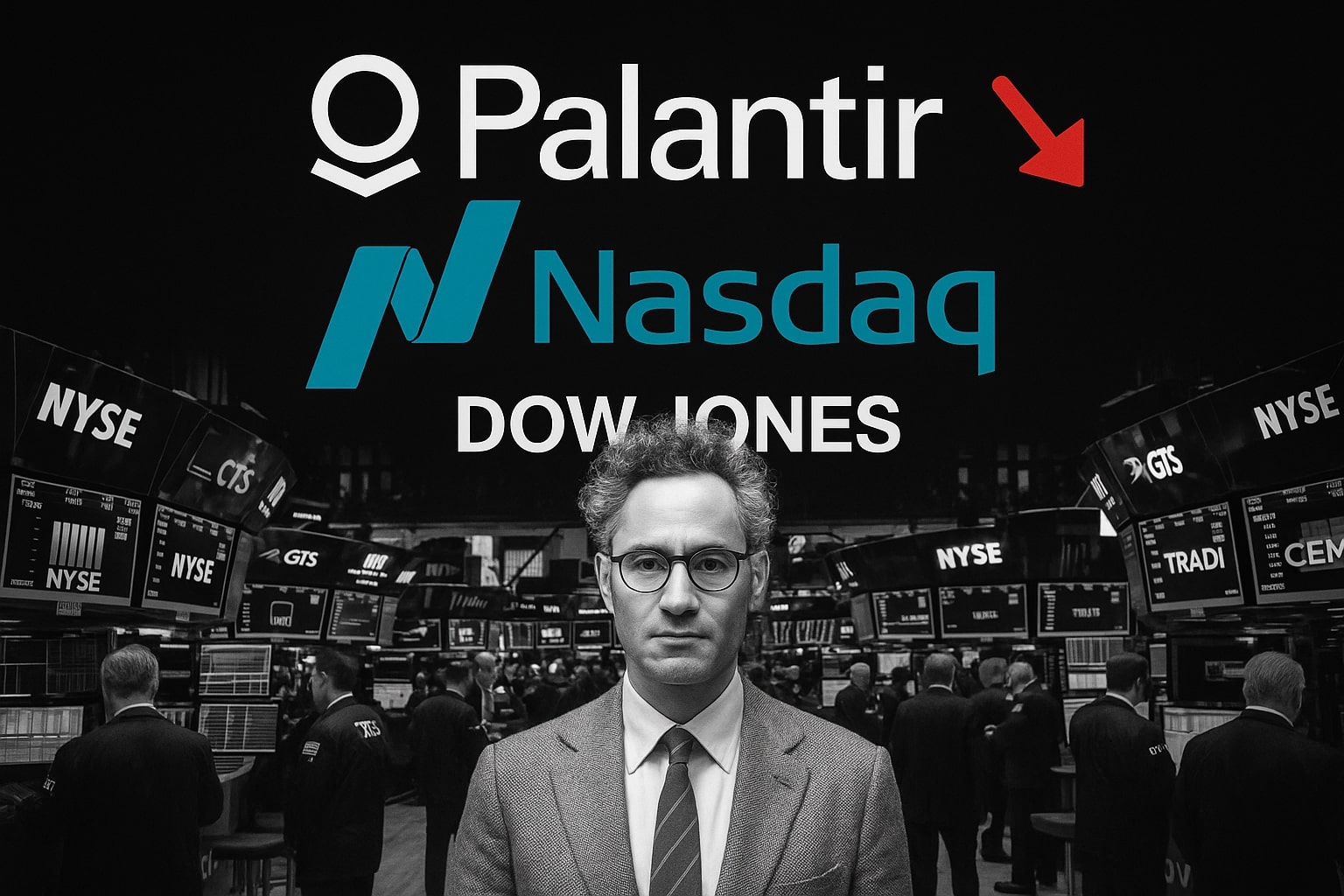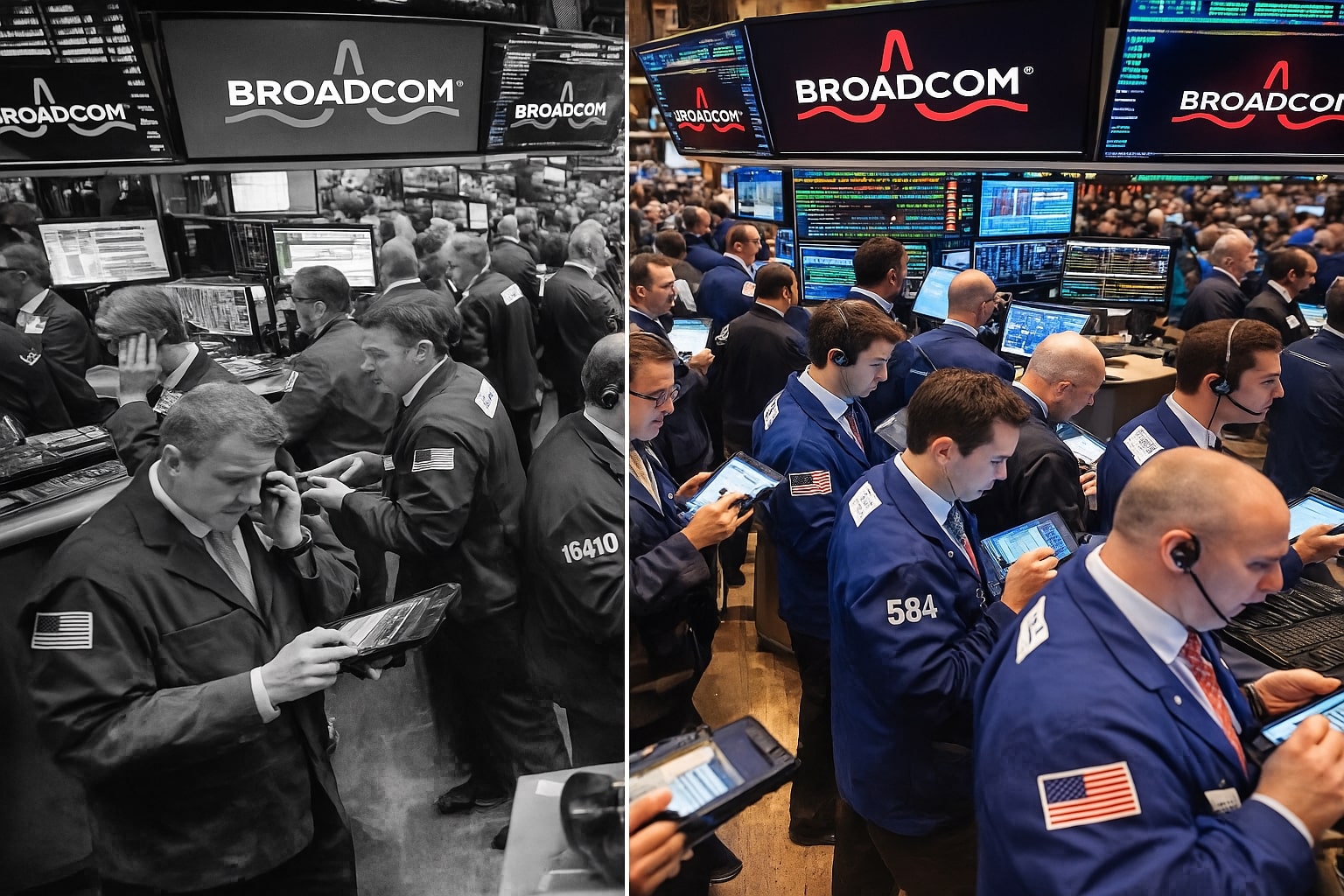
Stock Market Today: Nasdaq Drops 1.3%, PLTR Stock Crashes 8% as AI Rally Unwinds; Bitcoin BTC-USD Dips Below $103,000
S&P 500 fell 0.75% to 6,800.83, the Dow slipped 0.35% to 47,171.20, and gold broke below $4,000 while Bitcoin plunged 3.7% to $102,700 amid ETF outflows | That's TradingNEWS
Nasdaq Leads Tech Selloff as AI Valuations Trigger Broad Correction
U.S. equities slumped sharply on Tuesday, reversing recent momentum as stretched valuations in artificial intelligence names rattled investors. The Nasdaq Composite (IXIC) dropped 1.3%, while the S&P 500 (SPX) lost 0.75% and the Dow Jones Industrial Average (DJIA) slipped 0.35% to 47,171.20, retreating from last month’s record above 6,800. The tech-led weakness exposed the market’s fragility, with the Cboe Volatility Index (VIX) jumping 5.8% to 18.16, signaling renewed investor unease.
Leading the downturn was Palantir Technologies (NASDAQ:PLTR), collapsing 7–8% despite posting another quarter of record revenue, up 63% year-over-year to $1.18 billion. The company projected Q4 revenue between $1.33–$1.35 billion, exceeding consensus estimates of $1.19 billion, yet the market punished its stretched valuation—now hovering near a 700x forward P/E. The stock’s 150% year-to-date surge fueled skepticism that its AI-driven growth can sustain such pricing multiples. CEO Alex Karp’s fiery response to short-seller Michael Burry, who bet against both PLTR and Nvidia (NASDAQ:NVDA), underscored growing tension between bullish sentiment and fundamental restraint.
AI Sector Faces Reality Check After Record Run-Up
The broader AI cohort, which powered the market’s advance throughout 2025, faced its sharpest retracement in months. Advanced Micro Devices (NASDAQ:AMD) dropped 2% ahead of its Q3 earnings report, while Nvidia (NASDAQ:NVDA) pulled back 1.5% amid speculative fatigue. Oracle (NYSE:ORCL) slipped 2.5%, erasing part of its 50% year-to-date gain, while Amazon (NASDAQ:AMZN) edged lower following news of a $38 billion partnership with OpenAI via AWS to support next-generation AI models.
The S&P 500’s forward P/E ratio has surged beyond 23x, nearing 2000-era levels, raising fears of an AI bubble forming atop narrow market leadership. Analysts noted that over 300 S&P 500 components closed in the red Monday, exposing weak market breadth as megacaps like NVDA, AMZN, and PLTR mask underperformance in most sectors. Goldman Sachs CEO David Solomon and Morgan Stanley’s Ted Pick warned of a potential 10–20% market drawdown in the next 12–24 months, arguing valuations have detached from sustainable earnings trajectories.
Earnings Season Highlights Divergent Corporate Fortunes
Earnings releases painted a fractured picture of U.S. corporate health. Uber Technologies (NASDAQ:UBER) dropped nearly 7% despite reporting Q3 revenue of $13.47 billion, up 20% YoY, and record net income of $6.6 billion ($3.11 per share) boosted by a $4.9 billion tax valuation gain. However, its Q4 EBITDA forecast of $2.41–$2.51 billion underwhelmed investors, missing the $2.49 billion consensus midpoint.
Spotify Technology (NYSE:SPOT) posted a strong quarter with EPS of €3.28 versus €1.97 expected, and revenue of €4.27 billion, above forecasts. Monthly active users grew 11% to 713 million, exceeding guidance, yet shares slipped 2% as profit-taking set in after recent highs.
Marriott International (NASDAQ:MAR) advanced 4% after beating estimates with EPS of $2.47 on $6.49 billion in revenue, signaling ongoing resilience in global travel. RevPAR rose 0.5% globally but dipped 0.4% in the U.S. and Canada, as domestic consumers showed early signs of fatigue. Management expects 5% room expansion this year, pushing the global footprint beyond 1.8 million rooms.
In contrast, Norwegian Cruise Line Holdings (NYSE:NCLH) plunged 8–9% as Q3 revenue of $2.94 billion missed expectations of $3.02 billion, dragging peers Royal Caribbean (NYSE:RCL) and Carnival Corp. (NYSE:CCL) down 5–7%. The cruise sector’s volatility underscored consumers’ retreat from discretionary travel spending amid tightening credit conditions.
Read More
-
Palantir Stock Price Forecast - Can a $440B AI Defense Powerhouse Grow Into Its $184.74 Price?
16.12.2025 · TradingNEWS ArchiveStocks
-
XRP Price Forecast - XRP-USD Drops to $1.87 as Whale Dumps $721M While XRP ETFs Quietly Cross $1B
16.12.2025 · TradingNEWS ArchiveCrypto
-
Oil Price Forecast - Oil Slide Hard; WTI CL=F Near $55, Brent BZ=F Below $60 as Market Bets on 2026 Supply Glut
16.12.2025 · TradingNEWS ArchiveCommodities
-
Stock Market Today: Dow (^DJI) 48,404 And S&P 500 (^GSPC) 6,812 Slip As Jobs Hit +64K And AVGO Sells Off
16.12.2025 · TradingNEWS ArchiveMarkets
-
GBP/USD Price Forecast - Pairs at 1.34 as Weak U.S. Jobs Data Clash with BoE Cut Bets into Year-End
16.12.2025 · TradingNEWS ArchiveForex
Consumer and Healthcare Stocks Mixed as M&A Reshapes Landscape
Consumer product giant Kimberly-Clark (NYSE:KMB) fell after Evercore ISI downgraded it following its $40 billion acquisition of Kenvue, citing execution risk as the firm juggles restructuring and a complex joint venture with Suzano (NYSE:SUZ). Analysts flagged potential Tylenol-related liabilities and muted EPS growth projections through 2027–2028, limiting upside potential.
In healthcare, Sarepta Therapeutics (NASDAQ:SRPT) cratered 35–36% after late-stage studies for its Duchenne muscular dystrophy therapy failed to meet key endpoints. The collapse erased nearly $4 billion in market value, marking one of the steepest biotech drops of the quarter.
Meanwhile, Denny’s (NASDAQ:DENN) surged 50% after agreeing to a $620 million buyout by TriArtisan Capital, Treville Capital, and Yadav Enterprises, valuing each share at $6.25 in cash—an escape hatch for investors after a year of heavy losses.
Commodities, Crypto, and Currencies Reflect Defensive Rotation
Commodities weakened alongside equities. West Texas Intermediate (CL=F) slipped 0.8% to $60.55 per barrel, while Gold (XAU/USD) fell 1% to $3,970 per ounce, breaking below psychological support at $4,000. The U.S. 10-year Treasury yield eased to 4.09%, reflecting modest safe-haven demand, while the Dollar Index (DXY) firmed 0.2% to 97.15.
In digital assets, Bitcoin (BTC-USD) plunged 3.7% to $102,700, marking its lowest level since June and extending losses from the October peak above $126,000. ETF outflows totaled $1.3 billion from spot Bitcoin products including BlackRock’s IBIT, Fidelity’s FBTC, and Grayscale’s GBTC, while spot Ether ETFs saw another $500 million exit. The Fear & Greed Index slipped into “fear” territory as traders positioned for sub-$100,000 retests.
Macro and Global Indices: Profit-Taking Accelerates
In Europe, the Stoxx 600 (STOXX) declined 0.34%, while Japan’s Nikkei 225 (NI225) sank 1.7% and Topix dropped 0.65%, following a broad selloff in tech exporters. The risk-off tone was amplified by comments from Treasury Secretary Scott Bessent, who defended Trump’s new tariff framework under emergency powers, escalating trade tensions with China.
Meanwhile, the KBW Nasdaq Bank Index (BKX) inched 0.35% higher as investors rotated into financials amid expectations of resilient earnings. However, liquidity-sensitive assets—particularly high-multiple AI and growth names—bore the brunt of the pullback.
Market Sentiment Turns Cautious Amid Overheating Concerns
Investor sentiment shifted sharply after months of relentless optimism. The market’s dependency on a narrow band of AI-related mega-caps has inflated systemic risk, leaving indices vulnerable to earnings disappointments. As the S&P 500 hovers just 1% below record territory, strategists warn that continued compression in market breadth could trigger a multi-month correction if bond yields fail to stabilize.
Fed rhetoric further clouds the outlook. Comments from Fed Governor Lisa Cook labeling the December meeting as “live” and Mary Daly’s acknowledgment of “open minds” regarding inflation data have reduced expectations for immediate rate cuts. The combination of uncertain monetary policy, stretched equity multiples, and softening macro data is tilting institutional flows toward defensive sectors and cash-equivalent instruments.
Outlook: AI Euphoria Fades as Valuation Gravity Returns
The market’s reaction to strong yet overvalued AI earnings underscores a shift from narrative-driven buying to results-driven scrutiny. PLTR, NVDA, and AMD remain structurally strong but face near-term multiple compression risk. Financials like Goldman Sachs (NYSE:GS) and Morgan Stanley (NYSE:MS) may outperform on valuation normalization, while travel names like MAR and YUM could benefit from consumer resilience abroad.
Verdict: The short-term tone across indices leans bearish, with rising volatility, narrow breadth, and fading AI momentum signaling consolidation ahead. S&P 500 is a Hold, Nasdaq a short-term Sell, and Dow Jones a relative outperformer (Buy) on defensive positioning and dividend yield strength. Bitcoin’s correction below $103,000 and gold’s retreat under $4,000 reinforce a liquidity squeeze narrative consistent with profit-taking after record highs.


















